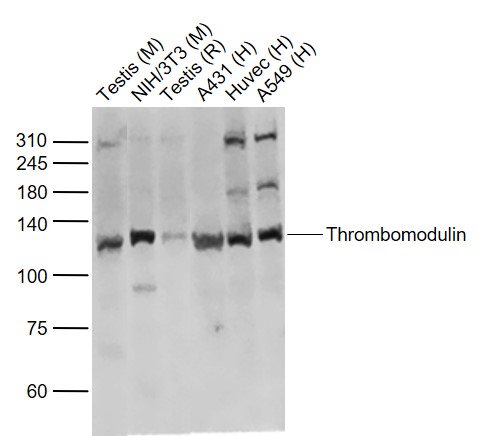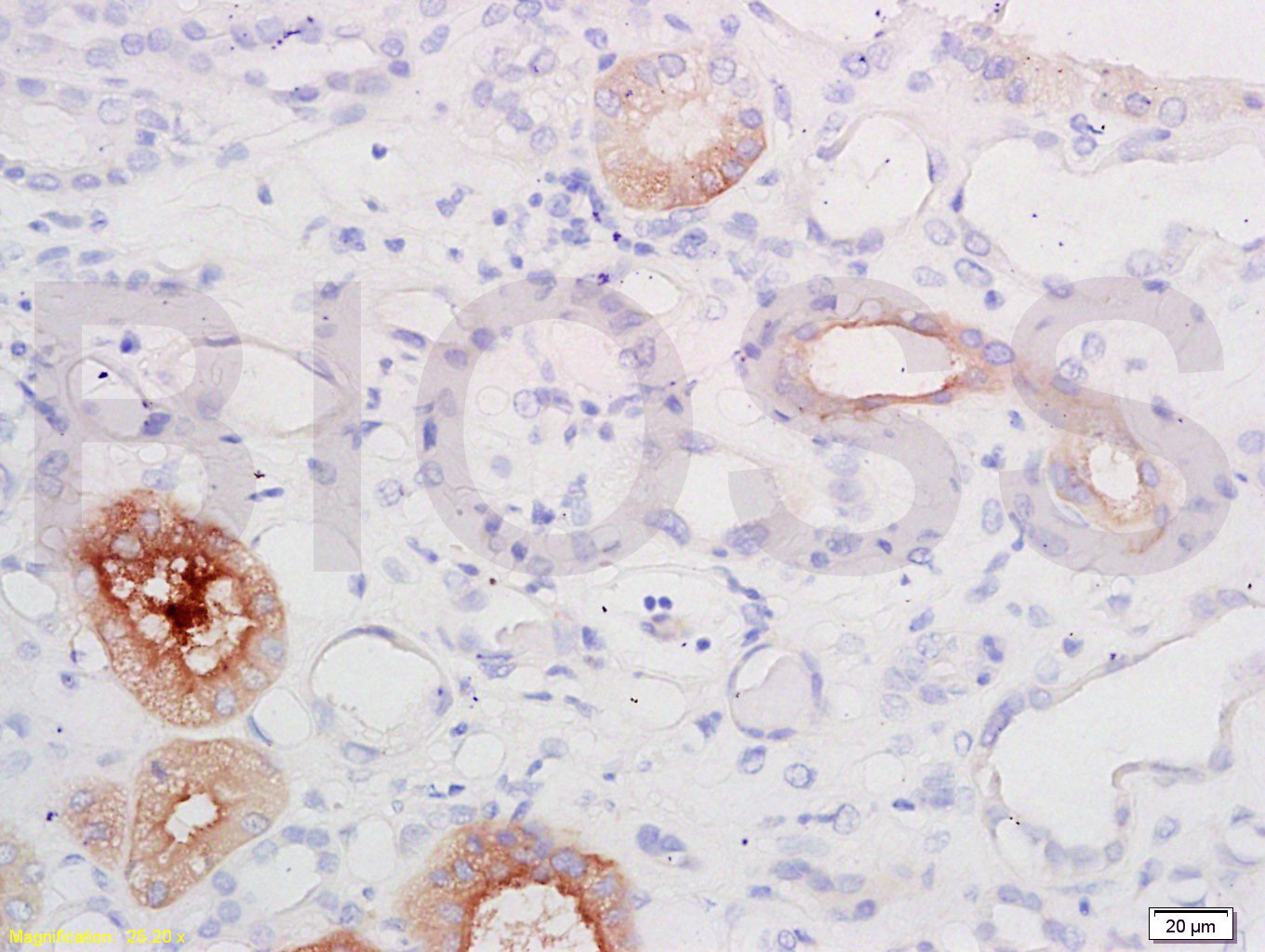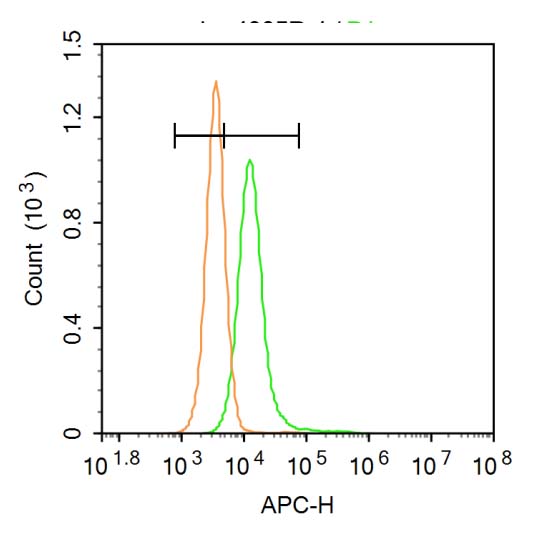
Rabbit Anti-Thrombomodulin antibody
CD 141; CD141; CD141 antigen; Fetomodulin; THBD; THRM; TM; AHUS 6; AHUS6; BDCA 3; BDCA3; THPH12; TRBM_HUMAN.
View History [Clear]
Details
Product Name Thrombomodulin Chinese Name 血栓调节蛋白抗体 Alias CD 141; CD141; CD141 antigen; Fetomodulin; THBD; THRM; TM; AHUS 6; AHUS6; BDCA 3; BDCA3; THPH12; TRBM_HUMAN. literatures Research Area Cardiovascular Cell biology Neurobiology vascular endothelial cell Immunogen Species Rabbit Clonality Polyclonal React Species Human, Mouse, Rat, (predicted: Dog, Cow, ) Applications WB=1:500-2000 ELISA=1:5000-10000 IHC-P=1:100-500 IHC-F=1:100-500 IF=1:100-500 (Paraffin sections need antigen repair)
not yet tested in other applications.
optimal dilutions/concentrations should be determined by the end user.Theoretical molecular weight 61kDa Cellular localization The cell membrane Form Liquid Concentration 1mg/ml immunogen KLH conjugated synthetic peptide derived from mouse Thrombomodulin: 301-400/575 <Extracellular> Lsotype IgG Purification affinity purified by Protein A Buffer Solution 0.01M TBS(pH7.4) with 1% BSA, 0.03% Proclin300 and 50% Glycerol. Storage Shipped at 4℃. Store at -20 °C for one year. Avoid repeated freeze/thaw cycles. Attention This product as supplied is intended for research use only, not for use in human, therapeutic or diagnostic applications. PubMed PubMed Product Detail Thrombomodulin, TM is cell surface glycoprotein; plays an important role in the protein C anticoagulant pathway. It located in a vein, artery and capillary endothelial cells on the surface of plasma membrane protein. It is generally believed: TM vascular endothelial injury is an important parameter is the thrombin receptor, known in a variety of normal human tissues, can also be expressed in many tumors, TM may be similar to the E-cadherin,and is a lectin Like activity of a new class of members of the cell adhesion molecules.
CD141/Thrombomodulin is an exclusively endothelial cell surface glycoprotein that forms a 1:1 complex with thrombin. Binding of thrombin to this high-affinity receptor alters its specificity toward several substrates. The complex activates protein C approximately 1000 times faster than thrombin alone. Activated protein C degrades clotting factors V and VIII; thus, thrombomodulin converts thrombin into a physiologic anticoagulant. Thrombomodulin is also found in the circulatory and urinary systems, the physiologic significance of this is obscure.
Function:
Thrombomodulin is a specific endothelial cell receptor that forms a 1:1 stoichiometric complex with thrombin. This complex is responsible for the conversion of protein C to the activated protein C (protein Ca). Once evolved, protein Ca scissions the activated cofactors of the coagulation mechanism, factor Va and factor VIIIa, and thereby reduces the amount of thrombin generated.
Subcellular Location:
Membrane; Single-pass type I membrane protein.
Tissue Specificity:
Endothelial cells are unique in synthesizing thrombomodulin.
Post-translational modifications:
N-glycosylated.
The iron and 2-oxoglutarate dependent 3-hydroxylation of aspartate and asparagine is (R) stereospecific within EGF domains.
DISEASE:
Defects in THBD are the cause of thrombophilia due to thrombomodulin defect (THPH12) [MIM:614486]. A hemostatic disorder characterized by a tendency to thrombosis.
Defects in THBD are a cause of susceptibility to hemolytic uremic syndrome atypical type 6 (AHUS6) [MIM:612926]. An atypical form of hemolytic uremic syndrome. It is a complex genetic disease characterized by microangiopathic hemolytic anemia, thrombocytopenia, renal failure and absence of episodes of enterocolitis and diarrhea. In contrast to typical hemolytic uremic syndrome, atypical forms have a poorer prognosis, with higher death rates and frequent progression to end-stage renal disease. Note=Susceptibility to the development of atypical hemolytic uremic syndrome can be conferred by mutations in various components of or regulatory factors in the complement cascade system. Other genes may play a role in modifying the phenotype.
Similarity:
Contains 1 C-type lectin domain.
Contains 6 EGF-like domains.
SWISS:
P07204
Gene ID:
7056
Database links:Entrez Gene: 7056 Human
Omim: 188040 Human
SwissProt: P07204 Human
Unigene: 2030 Human
血栓调节蛋白(thrombomodulin,TM)是一种分布于静脉、动脉和毛细vascular endothelial cell表面的质膜蛋白。 一般认为:TM是血管内皮损伤的重要参数,也是凝血酶的受体,已知在人类多种正常组织中表达,亦可表达于许多Tumour组织,TM可能类似于钙粘蛋白,是具有凝集素样活性的新一类Cell adhesion molecule的成员。TM是vascular endothelial cell膜上的凝血酶受体之一。与凝血酶结合后可降低凝血酶的凝血活性,而加强其激活蛋白C的活性。由于被激活的蛋白C具有抗凝作用,因此,TM是使凝血酶由促凝转向抗凝的重要的血管内凝血抑制因子。Product Picture
Lane 1: Testis (Mouse) Tissue Lysate at 40 ug
Lane 2: NIH/3T3 (Mouse) Cell Lysate at 30 ug
Lane 3: Testis (Rat) Tissue Lysate at 40 ug
Lane 4: A431 (Human) Cell Lysate at 30 ug
Lane 5: Huvec (Human) Cell Lysate at 30 ug
Lane 6: A549 (Human) Cell Lysate at 30 ug
Primary: Anti-Thrombomodulin (SL0525R) at 1/1000 dilution
Secondary: IRDye800CW Goat Anti-Rabbit IgG at 1/20000 dilution
Predicted band size: 61 kD
Observed band size: 120 kD
(IHC)Immunohistochemistry Tissue/cell: human kidney tissue; 4% Paraformaldehyde-fixed and paraffin-embedded;
Antigen retrieval: citrate buffer ( 0.01M, pH 6.0 ), Boiling bathing for 15min; Block endogenous peroxidase by 3% Hydrogen peroxide for 30min; Blocking buffer (normal goat serum,C-0005) at 37℃ for 20 min;
Incubation: Anti-Thrombomodulin Polyclonal Antibody, Unconjugated(SL0525R) 1:300, overnight at 4°C, followed by conjugation to the secondary antibody(SP-0023) and DAB(C-0010) staining
Blank control: A431.
Primary Antibody (green line): Rabbit Anti-Thrombomodulin antibody (SL0525R)
Dilution: 3μg /10^6 cells;
Isotype Control Antibody (orange line): Rabbit IgG .
Secondary Antibody: Goat anti-rabbit IgG-AF647
Dilution: 3μg /test.
Protocol
The cells were incubated in 5%BSA to block non-specific protein-protein interactions for 30 min at at room temperature .Cells stained with Primary Antibody for 30 min at room temperature. The secondary antibody used for 40 min at room temperature. Acquisition of 20,000 events was performed.
Bought notes(bought amounts latest0)
No one bought this product
User Comment(Total0User Comment Num)
- No comment





 +86 571 56623320
+86 571 56623320
 +86 18668110335
+86 18668110335

